Samsung Epic 4G Review: The Fastest Android Phone
by Anand Lal Shimpi on September 6, 2010 5:28 PM EST- Posted in
- Smartphones
- Samsung
- Epic 4G
- Gadgets
- Mobile
The Display: Like AMOLED, but Super
Did I mention Samsung also makes displays? The Epic 4G and the rest of the Galaxy S line are among the first to use a new type of active matrix OLED called Super AMOLED. The main difference appears to be that the capacitive touch layer and AMOLED are now integrated rather than laying on top of one another. This sounds a lot like the manufacturing technique used in Apple’s Retina Display. It’s supposed to reduce unwanted glare/reflections and improve the efficiency of the display.
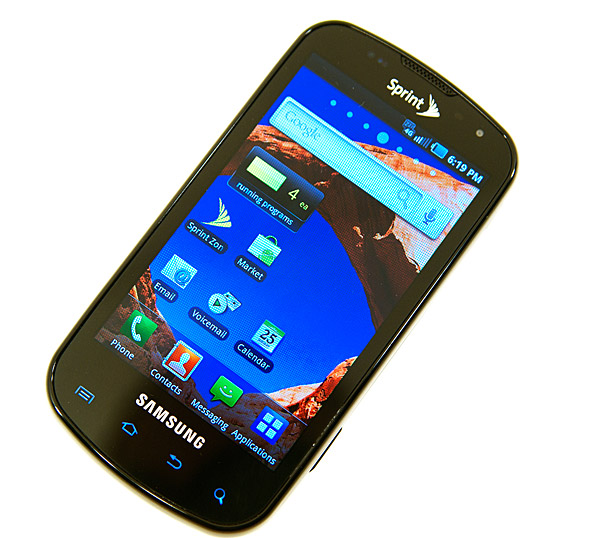
The end result is very noticeable. The Epic 4G is much easier to read outdoors compared to the original AMOLED Android phones like the Nexus One:
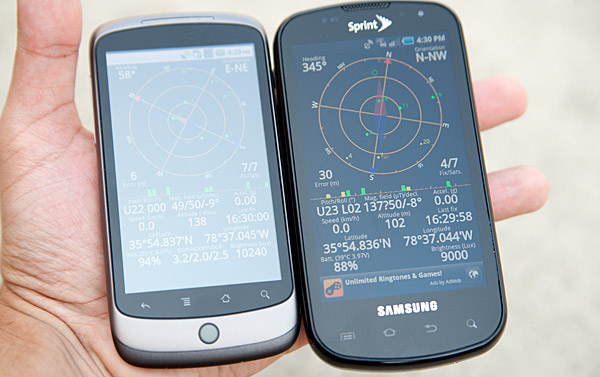
Google Nexus One AMOLED (left) vs. Samsung Epic 4G Super AMOLED (right)
The Super AMOLED display is a nice improvement over the standard AMOLED. I’d even go as far as to say that it’s comparable to most LCDs in direct sunlight, at least when you’re looking at things that aren’t white. Displaying white is a problem for AMOLED screens, it eats up a ton of power since the technology is emissive without the use of a backlight.
Direct Sunlight
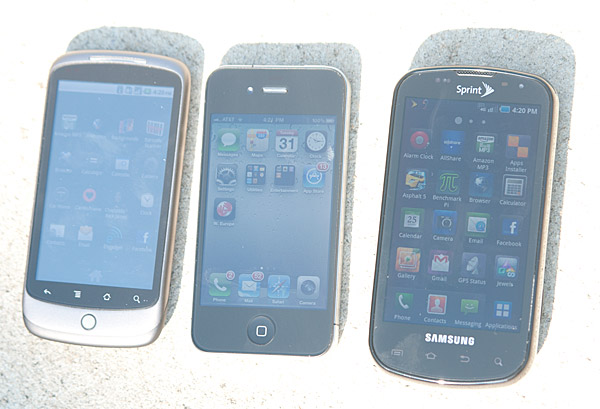
From left to right: Google Nexus One, Apple iPhone 4, Samsung Epic 4G
Shaded, Outdoors
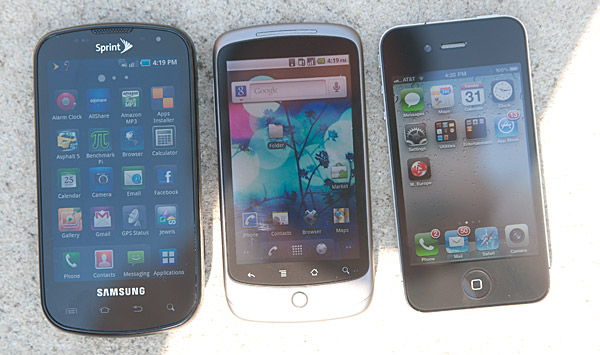
From left to right: Samsung Epic 4G, Google Nexus One, Apple iPhone 4
The biggest selling point of AMOLED is its deep blacks, which the Epic 4G’s display delivers perfectly. The display is almost too contrasty. The bright blue text on black background in the settings pages just pops.
Brightness is an issue with the display. The brightest white I measured was only 300 nits:
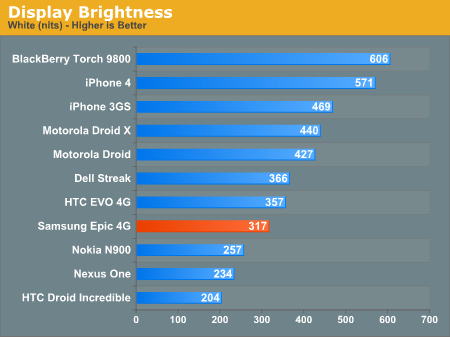
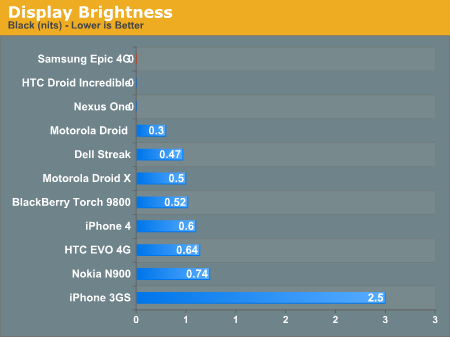
Samsung gets away with a relatively dim device by having perfect black levels, but the display’s weakness is visible when reading web pages with mostly white backgrounds.
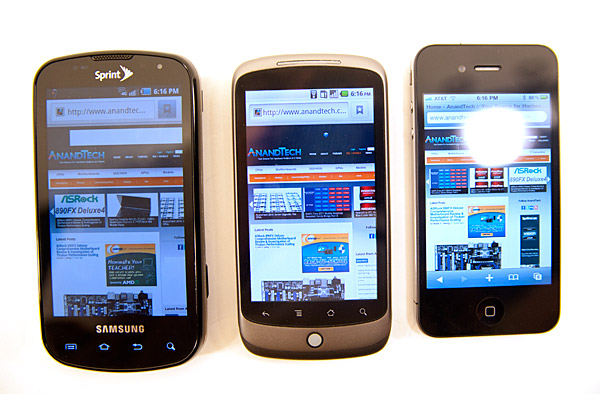
From left to right: Samsung Epic 4G, Google Nexus One, Apple iPhone 4
In the photo above, the Nexus One looks brighter, but the Epic 4G's white levels measure higher. I suspect this may be a Super AMOLED vs. AMOLED issue with our x-rite colorimeter. In practice the Nexus One has brighter pure whites while the Epic 4G has a brighter display in any other situation (e.g. home screen).
As AdamPflug correctly pointed out, the Epic 4G's web browser has a separate brightness setting which explains the difference in brightness above in the browser. In this case the brightness was set to around 20% of maximum on the Epic 4G.
Samsung includes a dynamic display feature that reduces brightness depending on the contents of the screen (there’s also the standard auto brightness based on ambient light). It’s not that noticeable when turned on in most situations but it reduces maximum brightness by about 100 nits. Again, this is mostly an issue with web pages that have a lot of white in them.
I’d say Samsung’s Super AMOLED is in the running for best display on a smartphone up there with the iPhone 4’s Retina Display. Apple has the resolution advantage, but Samsung has a huge contrast advantage. The former is nicer for reading text, while the latter is better for just about everything else.
Even if you don’t get the Epic 4G, Super AMOLED displays are where it’s at. They’re far more usable outdoors and you still get the contrast benefits of AMOLED.










93 Comments
View All Comments
Chaitanya - Tuesday, September 7, 2010 - link
GPS receiver on almost all Samsung phones is bad. Its no surprise that Epic 4G is an epic fail when it came to GPS performance.medi01 - Tuesday, September 7, 2010 - link
The Apple fanboism in anandtech's articles is getting more and more annoying... :("The move to Super AMOLED is key. With Super AMOLED the Epic 4G improves outdoor usability significantly."
To bad we can't see it on the pictures you've made.
Anand Lal Shimpi - Tuesday, September 7, 2010 - link
I believe this shot illustrates the huge improvement over standard AMOLED displays:http://images.anandtech.com/reviews/gadgets/Samsun...
Glare/reflections have been reduced significantly.
Take care,
Anand
pervisanathema - Tuesday, September 7, 2010 - link
noticed this on page 2:"The back cover snaps off with relative ease revealing the 1500mAh battery, a microSD card slow."
I'm sure you mean slot instead of slow. :)
Anand Lal Shimpi - Tuesday, September 7, 2010 - link
Thanks for the correction :)Take care,
Anand
DoubleVanos - Tuesday, September 7, 2010 - link
Battery life seems fine on my AT&T Captivate to be honest. It can easily go on for a full day with a lot of usage. It must be a Sprint thing I guess.MaxMax - Tuesday, September 7, 2010 - link
WTF !I don't know why always Sprint and Verizon gets the best Android phones comparing to T-Mobile and AT&T !!
This one have flash LED while the other galaxy s doesn't !!
Anand Lal Shimpi - Tuesday, September 7, 2010 - link
Haha yep, fixed! Thank you!vision33r - Tuesday, September 7, 2010 - link
There's a very good reason RIM and Apple have lower clocked CPUs, Apple's A4 processor is running only at 60% of it's full clock speed.Battery life.
Remember smartphones are still phones and talk time is more important than mhz.
Most Blackberrys still run under 500MHZ and they do email, web browsing, and light apps just fine.
Why would Android need 1.2GHZ just to run apps? What apps need 1.2GHZ?
That's just not efficient design for mobile apps.
bplewis24 - Tuesday, September 7, 2010 - link
I guess I'm one of the lucky ones. I must own the only Android phone that is just as fast as my girlfriend's iPhone3GS or my colleagues iPhone4 with no more in the way of choppy animations and stuttering than they have.Brandon